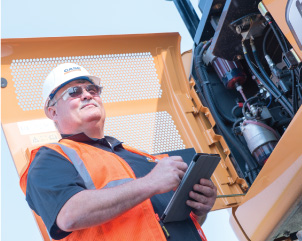Best Practices
Soil Compaction
Soil compaction increases the load-bearing capacity of the soil, adding stability. It also prevents soil settlement and water seepage, which can cause unnecessary maintenance costs and structure failure.
Before Compacting
Know your soil
Identify the soil group you are working with before you begin compacting, as different soil types have different maximum densities and optimum moisture levels. The three basic soil groups are: cohesive, granular, and organic. Cohesive soils, such as clay, have particles that stick together. Granualar soils, such as sand, have no clay content, and crumble easily. Organic soils are not suitable for compaction.
Moisture
Before you begin compacting, you need to determine the moisture content of the soil. Too little moisture results in inadequate compaction. Too much moisture weakens stability.
The easiest way to test the moisture content of soil is the "Hand Test." Pick up a handful of soil, squeeze it, and then open your hand. You want the soil to be moldable and break into a few pieces when dropped. If the soil is powdery and shatters when dropped, it is too dry. If the soil leaves moisture in your hand and remains in one piece when dropped, it has too much moisture.
The right equipment
For best results, use a machine that applies a vibratory force to the soil, such as vibratory or oscillating rollers. These machines apply a rapid series of blows to the surface of the soil, which impacts the deep layers below the surface, resulting in better compaction.
A pad-foot roller should be used when working with cohesive soil. When working with granular soils, vibratory rollers are the best choice. When using non-vibratory rollers, the degree of compaction depends on the weight of the machine. The heavier the machine, the more effective the compaction.
During Compaction
Do not overcompact
If you make too many passes in one direction with your compaction machine you can overcompact the soil. Overcompaction reduces soil density, wastes time, and causes unnecessary wear to the compaction machine.
Prevent a rollover
Inspect work surfaces for dangerous inclines or declines. When operating rollers and compactors on uneven surfaces, the rollover hazard is increased significantly. Some machines are equipped with rollover protective structures (ROPS). The use of ROPS and seatbelts can greatly reduce the risk of injury in the event of a rollover.
Inspect tire pressure before operating rollers/compactors, as improperly inflated tires can destabilize the machines. Turning away from a slope on a compactor with articulated steering can also destabilize the compactor. Compacting soft edges can cause one side of the machine to sink and increase the risk of a rollover.
Exercise caution during trench compaction
Trench work brings additional hazards and compliance with safety regulations for compaction equipment operators. Make sure that someone knowledgeable about OSHA requirements inspects the excavation before compaction begins, daily before each shift, and as needed throughout the shift. In addition to a trench cave-in, operators must also be protected from falling objects. When possible, use remote control compaction equipment.

